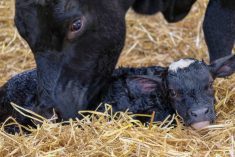The cost of putting replacement dairy heifers on the milk line has skyrocketed in the last few years. High feed prices drove most of this, but excellent heifer performance also contributes.
Since growing replacement heifers don’t generate any income until they enter the lactation barn, it’s important to set up a well-balanced feeding program that matches their nutrient requirements. In this way we can efficiently utilize our feed budget as it invests precious dollars that turn these growing dairy heifers into profitable milk cows.
WHAT ARE YOUR GOALS?
Read Also

Gentle treatments for pain in the neck
Heading toward year-end, people unknowingly tense up against the cold and busyness, causing neck pain that can often be treated with appropriate support and gentle mobility, athletic therapist Kathlyn Hossack says.
Before I consider what to feed or how much to spend on raising these replacement heifers, I set up a few goals that I expect to achieve by they are 24 months of age. Many dairy farms bring in a lot of poor-doers or destined-to-be culled heifers on the milk line because one or more of these goals was not met:
- Good body condition. All potential pre-weaned and post-weaned candidates for the milk line should not deviate from a BCS of 3.0 -3.5 (1 = emaciated and 5 = obese). This is because BCS mirrors how well we match the nutrition of their diet (particularly dietary energy) to calf growth requirements. We often think this applies only to replacement heifers for breeding, but it equally applies to the youngest baby calf.
- Promote “wise” dry matter feed intake of feed. A baby calf starts out at about a 1.5 kg per head per day, dry matter (DM) intake. Initially, she can digest only milk-based nutrients such as lactose carbohydrates. Within about two weeks, she can digest more complex carbohydrates in calf starter, which stimulates her small non-functioning rumen to grow. It gets inoculated with microbes from her environment and becomes fully functional by the time that she is about 12 weeks. I never try to rush this natural process — for post-weaned calves until breeding, I estimate their DM intake at about 2.5 per cent.
- Avoid challenging “as fed” intake. I recommend that post-weaned calves should be at least four to six months before feeding them significant amounts of silage. Also, feeding low-energy feeds should as straw should be avoided unless their purpose is to cut down the energy density of the diet.
- Achieve modest post-weaning heifer growth rates. Good dry matter intake of well-balanced replacement heifer diets should dovetail into desired post-weaning growth rates of 1.8-2.0 lbs. per day, and increased to 2.0-2.2 lbs. after puberty at about nine to 10 months. Exceeding these growth rates tends to produce over-conditioned or fat heifers. I achieve above optimum growth by formulating diets of all-encompassing dietary requirements of 64-67 per cent TDN and 14-16 per cent crude protein.
PROVIDE PROPER RATION
Once I have these goals in place, I am ready to set up a proper feeding program with an associated feed budget. For demonstration purposes, this example is set up in three simple ways:
1. Once calves are weaned from milk replacer (and calf starter), post-weaned heifers are fed a diet of high-quality mixed alfalfa-grass hay supplemented with a 16 per cent heifer complete feed pellet.
2. This feed pellet is discontinued once animals are bred and replaced by a heifer TMV (Trace mineral vitamin premix) and no grain is fed.
3. Corn silage is introduced at eight months and continued until calving. (To view the spreadsheet, visit the online edition of May 30 edition of Grainews ) Note: close-up feeding program is fed prior to calving, but not illustrated. I calculated a total feed investment of $2,300 per replacement heifer to bring her on the milk line. I also parallel the per cent cost of each feed as it relates to the total cost of overall diet (re: an opportunity to save money on significant inputs).
As a footnote, I added 70 cents per head daily of yardage, covering fuel and labour costs. However, I did not add the inherent cost of a newborn calf, the cull value of sold heifers, or close-up feeds or any gross housing-costs.
Despite these minor liberties, my feed budget for growing replacement dairy heifers is sound. It does a good job of merging both the goals of raising proper heifers with a proper replacement heifer feeding program and its major costs. Plus it’s easy to use, so anybody can input their own costs and determine their own invested feed budget.
















